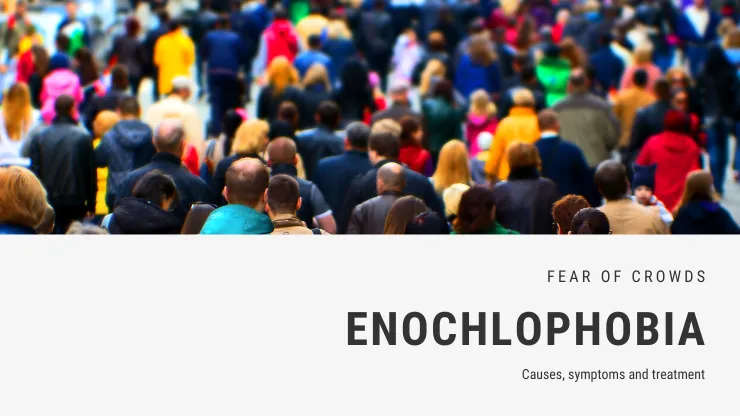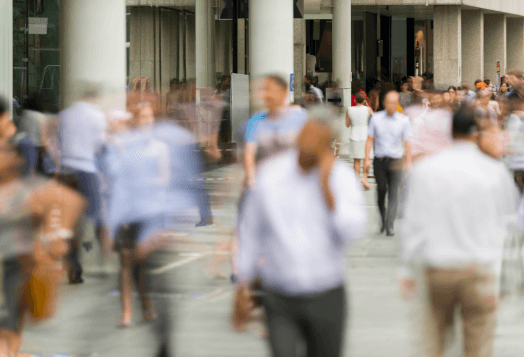For many, a bustling marketplace or a packed concert hall brings excitement. But for those suffering from enochlophobia, such environments can trigger overwhelming fear and anxiety. In this guide, we explore how to manage this fear of crowds, uncover the root causes, and share practical strategies for coping with this often-misunderstood condition.

What is Enochlophobia?
Enochlophobia refers to an intense, persistent fear of crowded places or large gatherings of people. This specific phobia can significantly impair one's ability to engage in everyday activities such as shopping, commuting, or attending events.
Signs of Enochlophobia
The symptoms can vary, but typically include both physical and emotional reactions:
Rapid heartbeat or chest tightness
Sweating or trembling
Dizziness or nausea
Panic attacks in crowds
An intense urge to escape or avoid crowded places
Emotional symptoms may include a constant sense of dread, anticipatory anxiety before social events, and depression linked to isolation.
Causes
Past trauma: A frightening experience in a crowded place can serve as a catalyst.
Genetics: A family history of anxiety disorders may predispose individuals.
Environmental influences: Growing up in chaotic or high-stress environments may heighten sensitivity to crowds.
Enochlophobia vs. Other Phobias
Although similar to social anxiety and agoraphobia, enochlophobia is unique, much like the distinct challenges of delusions of grandeur. Phobia of crowds vs. social anxiety often comes down to scope. Social anxiety is tied to the fear of being judged, while crowd anxiety disorder focuses strictly on the fear of physical crowding. Unlike agoraphobia, which involves a fear of being unable to escape, enochlophobia centres on the discomfort caused by the density of people.
How This Phobia Affects Daily Life
Living with this phobia can significantly alter one's daily routine and overall well-being.
1. Impact on Social Life
The social consequences of enochlophobia can be profound:
Avoidance of public gatherings, family events, or even going to restaurants
Reluctance to attend weddings, concerts, or festivals
Feelings of loneliness and isolation due to withdrawal from social interaction
2. Professional Implications
Many jobs involve presentations, client meetings, or team events. For someone with a phobia of crowds, this can hinder career progress:
Difficulty attending conferences or networking events
Challenges in public speaking roles or customer-facing duties
Increased risk of absenteeism and reduced job satisfaction
3. Physical and Emotional Toll
Avoiding crowded spaces comes at a cost:
Constant hypervigilance and planning to avoid triggers
Fatigue from elevated stress levels
Emotional distress, such as guilt or shame, from missing out
A clinical psychologist or mental health counsellor can provide strategies to reduce this toll and restore work-life balance.

Techniques to Overcome Fear of Crowds
Effectively managing the fear of crowded places requires a combination of professional help, self-awareness, and consistent effort.
1. Gradual Exposure Therapy
One highly recommended approach is Gradual Exposure Therapy. Also known as desensitisation, this technique involves slowly and systematically exposing oneself to crowded places in a controlled manner. For instance, you might start by simply visualising a busy setting while in the comfort of your home. As you become more comfortable, the next step could be visiting a quiet café or a semi-busy supermarket.
Over time, and with practice, you can work your way up to being in larger, more densely packed environments like shopping malls or train stations. Repeated exposure helps to reduce sensitivity and build tolerance, eventually easing this phobia.
2. Cognitive Behavioural Therapy (CBT)
Another powerful method is Cognitive Behavioural Therapy (CBT), which is widely endorsed for treating crowd anxiety disorder. This form of therapy helps individuals identify irrational or negative beliefs, such as ‘I’ll be trapped with no way out’, and replace them with more balanced thoughts like “I can always step away if I feel overwhelmed.” These reframed thoughts are practised during real-world exposures, helping the brain to form healthier associations with crowds. A CBT specialist can tailor this therapy to your unique triggers and emotional patterns.
3. Relaxation Techniques
Managing physical symptoms is crucial. Try these:
Deep breathing: Inhale for four counts, hold for four, exhale for four
Mindfulness meditation: Stay grounded in the present using sensory awareness
Progressive muscle relaxation: Release tension from head to toe
Such anxiety management practices support calmness in challenging environments.
.
4. Self-Help Strategies
Complementing professional strategies are self-help methods that can empower you in daily life. Journaling is an effective way to track your triggers and record progress over time. Positive affirmations such as ‘I am safe’ or ‘I can handle this situation’ help counteract fear-driven thoughts. Visualisation techniques, such as picturing yourself walking confidently through a busy street, can mentally prepare you for real-life challenges.
When to Seek Professional Help
Knowing when to get help is essential. If your fear disrupts daily life, professional support can be transformative.
1. Recognising the Need for Help
Consider therapy if you experience:
Persistent avoidance despite efforts to cope
Intense anxiety that interferes with relationships or work
Worsening symptoms despite time or self-help attempts
2. Therapy Options
Multiple treatments exist beyond traditional CBT:
EMDR (Eye Movement Desensitisation and Reprocessing): Particularly useful for trauma-based crowd phobia
Hypnotherapy: Accesses subconscious beliefs to reframe fears
Group therapy: Shared experiences can normalise and validate your feelings
A clinical psychologist or mental health counsellor will help you explore these therapy options for phobias.
3. Support Networks
It can be comforting to talk to others who understand your fears in online forums or in-person groups, mental health support organisations or with family and friends, once they understand your condition. A supportive environment promotes healing and makes the journey less isolating.

Moving Beyond the Fear of Crowds
Living with enochlophobia can be challenging, but it’s not insurmountable. Through professional help, lifestyle changes, and coping strategies, it is entirely possible to reclaim control over your life. If you or someone you know is struggling, don’t hesitate to seek help from a qualified mental health counsellor or phobia specialist. You are not alone, and with the right support, you can move from fear to freedom.
Disclaimer: The information provided is intended for general informational purposes only. It is not a substitute for professional advice or guidance. For personalised recommendations or specific concerns, please consult a certified professional.




